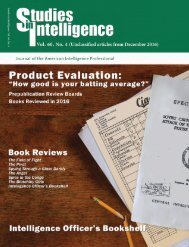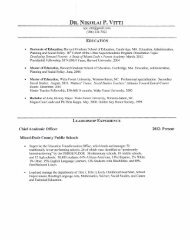r380-14
r380-14
r380-14
You also want an ePaper? Increase the reach of your titles
YUMPU automatically turns print PDFs into web optimized ePapers that Google loves.
R 380-<strong>14</strong>CHAPTER 5DERIVATIVE CLASSIFICATION5-1. DESCRIPTION. Most classified documents produced within USCENTCOM are the resultof derivative classification. Derivative classification is the act of incorporating, paraphrasing,restating, or generating in a new form any formation that is already determined to be classifiedby an OCA in a source document, classification guide, or other OCA guidance document. Theapplication of classification markings and declassification instructions to a document or othermaterial as directed by a security classification guide, security classification memorandum, asource document, or other source material is derivative classification. Under no circumstanceswill such information be cited as originally classified by an USCENTCOM classificationauthority.5-2. POLICY. USCENTCOM regulation 380-<strong>14</strong> is the Security Classification Guide (SCG).Any products derived from other agency documents will list that agency‟s document or in theuse of more than one document, an addendum will accompany the USCENTCOM product listingALL products used and their classification. Activity security managers will ensure all personnelderivatively classifying documents have been properly trained.5-3. INDIVIDUAL RESPONSIBILITY. All persons performing derivative classification will:a. Observe and respect the original classification decision unless superseded by OCAguidance, and carry forward to any newly created document the pertinent classification markingsfrom the source document(s), classification guide(s), or other applicable OCA guidance. Do not„downgrade‟ the information to ensure releaseability. Personnel will refer any requests toregrade the material to the originating agency or individual.b. Apply classification markings, declassification instructions, warning messages, or othermeans of identification to the derivatively classified material (see Chapter 6). When derivativelyclassifying from more than one classified source, use the highest level of classification and allthe caveats in accordance with the CAPCO guide on the top and bottom of the document or othermedia in order to afford the information the greatest degree of protection; include all the warningmessages from among the sources on the face (first page) of the document or media.c. Use only authorized sources of instructions about the classification of the information inquestion. Authorized sources of instructions about classification are security classificationguides, other forms of classification guidance, and markings on material from which theinformation is extracted.d. Include a list of all documents or sources used in the derivative classification appended tothe last page.e. Ensure the document is marked properly (see Chapter 6) and includes the date of origin andthe classification authority block on the face (first page) of each document or other media toindicate the name of the person and office symbol who derivatively classified the document; theauthority (after “Derived from” list the classification guide and date or the serial and the agency,5-1




